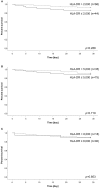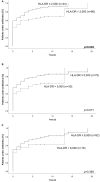Monocyte HLA-DR Assessment by a Novel Point-of-Care Device Is Feasible for Early Identification of ICU Patients With Complicated Courses-A Proof-of-Principle Study
- PMID: 30915080
- PMCID: PMC6423155
- DOI: 10.3389/fimmu.2019.00432
Monocyte HLA-DR Assessment by a Novel Point-of-Care Device Is Feasible for Early Identification of ICU Patients With Complicated Courses-A Proof-of-Principle Study
Abstract
Background: Critically ill patients, especially following trauma or extensive surgery, experience a systemic immune response, consisting of a pro-inflammatory as well as a counterbalancing anti-inflammatory response. Pro-inflammation is necessary for the initiation of homeostatic control and wound healing of the organism. However, when the counterbalancing mechanisms dominate, a condition of secondary immunodeficiency occurs, which renders the patient susceptible for opportunistic or secondary infections. However, the incidence of this condition is yet illusive. Methods: For a period of 3 months (May to July 2017), 110 consecutive patients admitted to the surgical ICU of the Heidelberg University Hospital, a tertiary university hospital, were enrolled in the study. Monocyte HLA-DR (mHLA-DR), a long-known surrogate of monocyte function, was assessed quantitatively once on admission utilizing a novel point-of-care flow cytometer with single-use cartridges (Accelix system). Patients were followed up for further 28 days and data on ICU stay, antibiotic therapy, microbiological findings, and mechanical ventilation were recorded. Statistical analysis was performed to evaluate the incidence of immunosuppression-defined by different thresholds-as well as its consequence in terms of outcome and clinical course. Results: Depending on the HLA-DR threshold applied for stratification (≤8,000/≤5,000/≤2,000 molecules/cell), a large group of patients (85.5/68.2/40.0%) already presented with a robust decrease of HLA-DR on admission, independent of the cause for critical illness. Analyzed for survival, neither threshold was able to stratify patients with a higher mortality. However, both thresholds of 2,000 and 5,000 were able to discriminate patients with longer ICU stay, ventilation time and duration of antibiotic therapy, as well as higher count of microbiological findings. Moreover, a mHLA-DR value ≤2,000 molecules/cell was associated with higher incidence of overall antibiotic therapy. Conclusion: Single assessment of mHLA-DR using a novel point-of-care flow cytometer is able to stratify patients according to their risk of a complicated course. Therefore, this device overcomes the technical boundaries for measuring cellular biomarkers and paves the way for future studies involving personalized immunotherapy to patients with a high immunological risk profile independent of their background. Trial Registration: German Clinical Trials Register; ID: DRKS00012348.
Keywords: CARS; SIRS; immunosuppression; infection; personalized medicine; precision medicine; sepsis; tolerance.
Figures




Similar articles
-
Reduced Monocytic Human Leukocyte Antigen-DR Expression Indicates Immunosuppression in Critically Ill COVID-19 Patients.Anesth Analg. 2020 Oct;131(4):993-999. doi: 10.1213/ANE.0000000000005044. Anesth Analg. 2020. PMID: 32925314 Free PMC article.
-
Monocytic HLA-DR expression in intensive care patients: interest for prognosis and secondary infection prediction.Crit Care Med. 2009 Oct;37(10):2746-52. doi: 10.1097/CCM.0b013e3181ab858a. Crit Care Med. 2009. PMID: 19707128
-
Lack of recovery in monocyte human leukocyte antigen-DR expression is independently associated with the development of sepsis after major trauma.Crit Care. 2010;14(6):R208. doi: 10.1186/cc9331. Epub 2010 Nov 19. Crit Care. 2010. PMID: 21092108 Free PMC article.
-
Monocyte HLA-DR Measurement by Flow Cytometry in COVID-19 Patients: An Interim Review.Cytometry A. 2020 Dec;97(12):1217-1221. doi: 10.1002/cyto.a.24249. Epub 2020 Nov 4. Cytometry A. 2020. PMID: 33125816 Review.
-
Utility of monocyte HLA-DR and rationale for therapeutic GM-CSF in sepsis immunoparalysis.Front Immunol. 2023 Feb 7;14:1130214. doi: 10.3389/fimmu.2023.1130214. eCollection 2023. Front Immunol. 2023. PMID: 36825018 Free PMC article. Review.
Cited by
-
Lymphocyte trajectories are associated with prognosis in critically ill patients: A convenient way to monitor immune status.Front Med (Lausanne). 2022 Aug 4;9:953103. doi: 10.3389/fmed.2022.953103. eCollection 2022. Front Med (Lausanne). 2022. PMID: 35991659 Free PMC article.
-
Dynamic LTR retrotransposon transcriptome landscape in septic shock patients.Crit Care. 2020 Mar 18;24(1):96. doi: 10.1186/s13054-020-2788-8. Crit Care. 2020. PMID: 32188504 Free PMC article.
-
Comparison of neutrophil CD64 and monocytic HLA-DR with existing biomarkers for the diagnosis and prognosis of sepsis.Anaesthesiol Intensive Ther. 2021;53(4):304-311. doi: 10.5114/ait.2021.108579. Anaesthesiol Intensive Ther. 2021. PMID: 35257562 Free PMC article.
-
A stratification strategy to predict secondary infection in critical illness-induced immune dysfunction: the REALIST score.Ann Intensive Care. 2022 Aug 17;12(1):76. doi: 10.1186/s13613-022-01051-3. Ann Intensive Care. 2022. PMID: 35976460 Free PMC article.
-
Production of IL-6 and Phagocytosis Are the Most Resilient Immune Functions in Metabolically Compromised Human Monocytes.Front Immunol. 2021 Oct 19;12:730672. doi: 10.3389/fimmu.2021.730672. eCollection 2021. Front Immunol. 2021. PMID: 34737742 Free PMC article.
References
Publication types
MeSH terms
Substances
LinkOut - more resources
Full Text Sources
Research Materials

